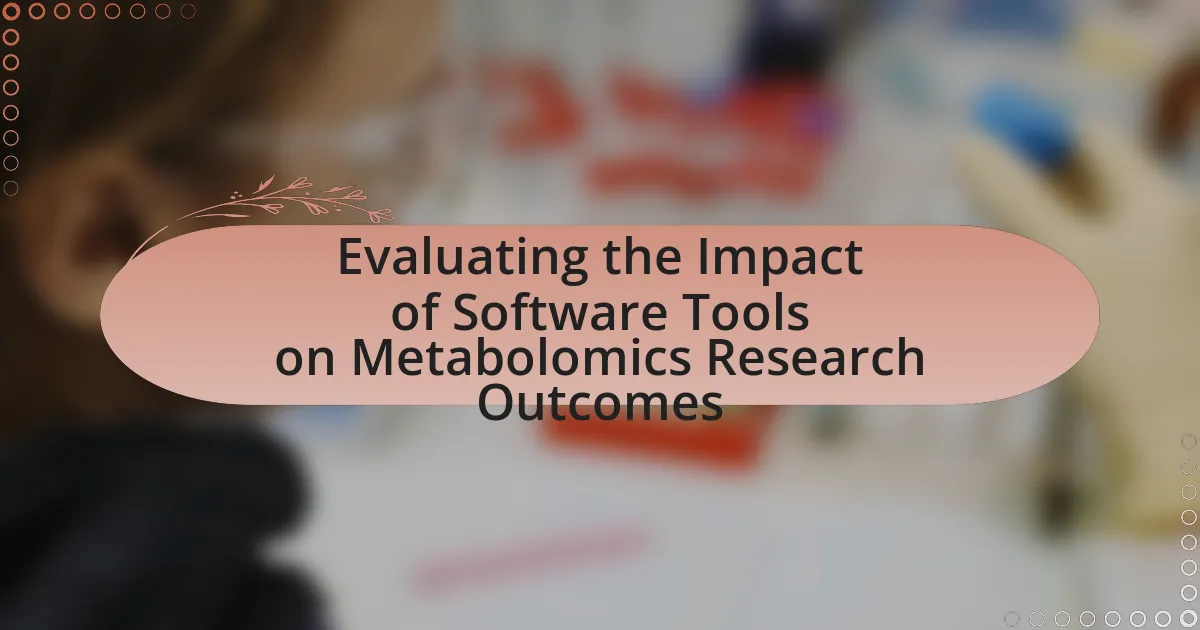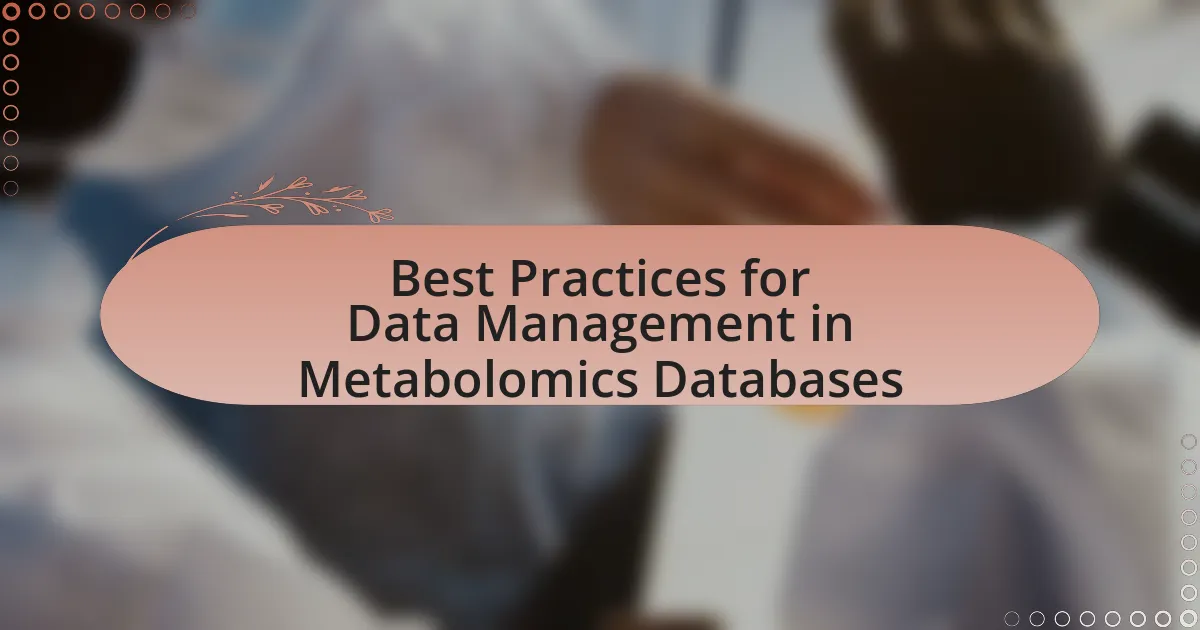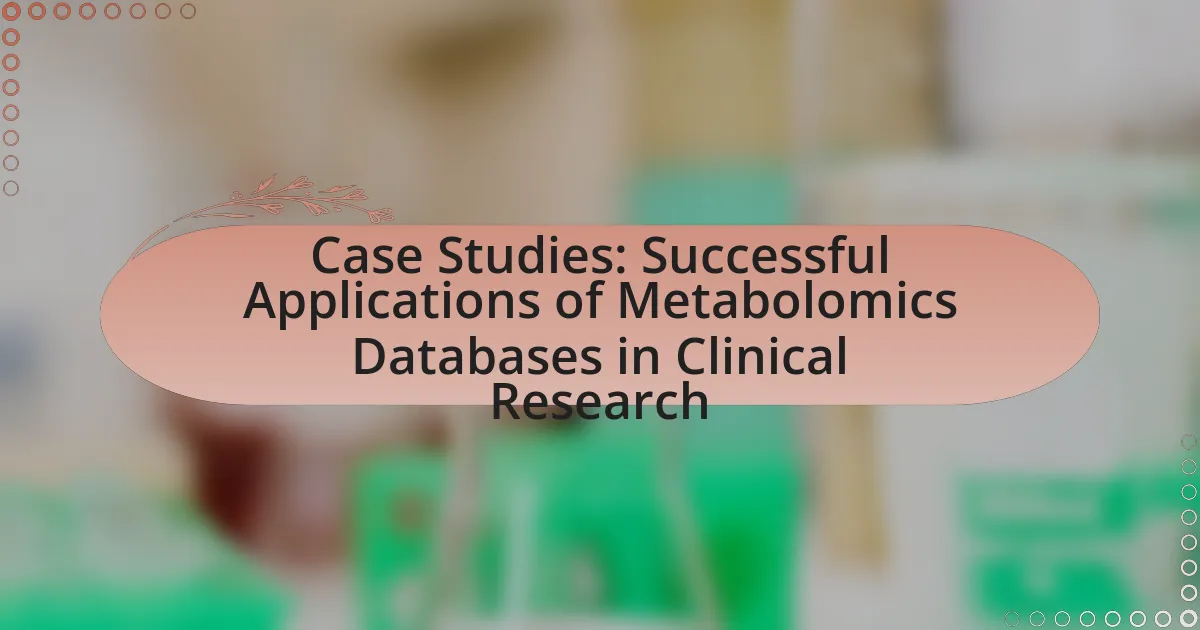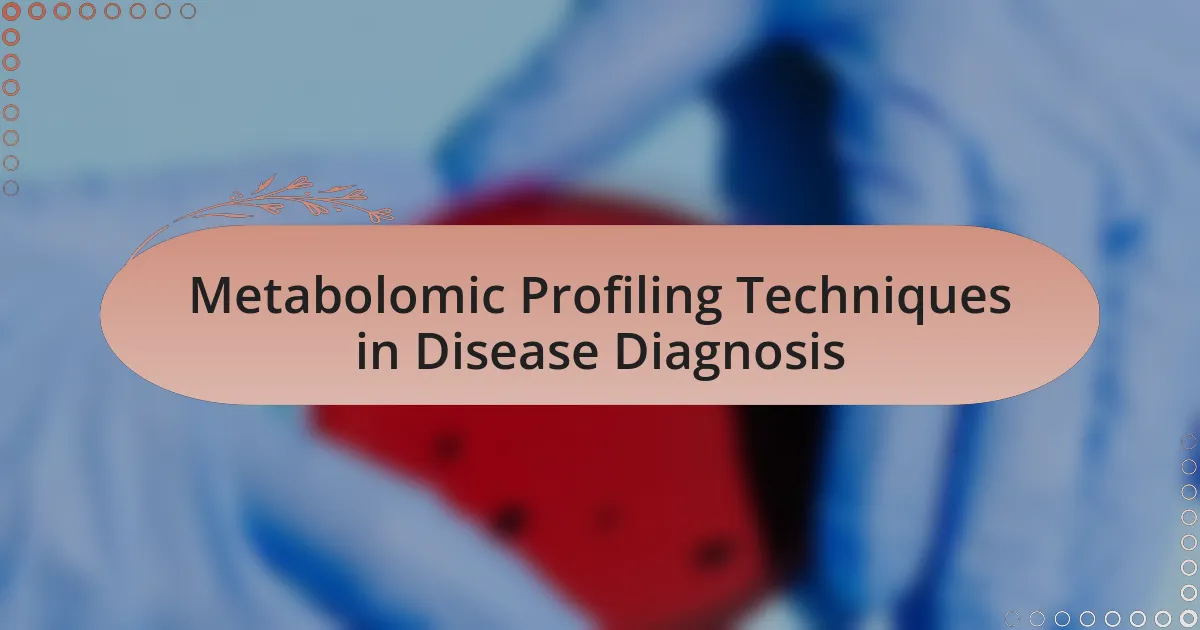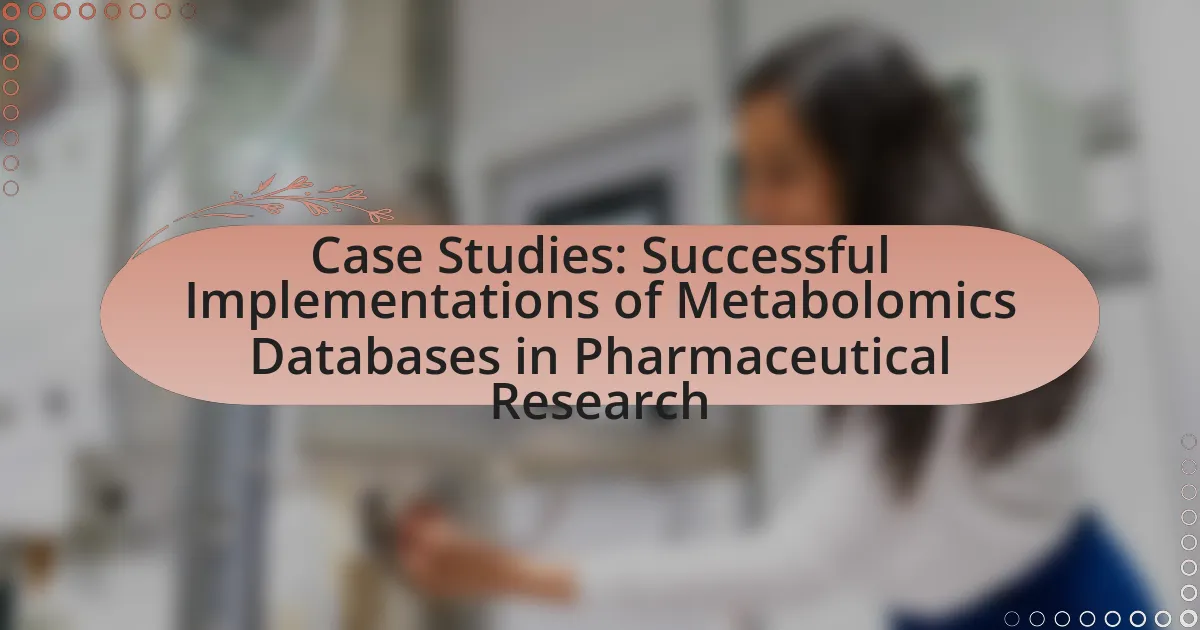The article focuses on the future trends in metabolomics software development, highlighting the integration of artificial intelligence (AI) and machine learning for enhanced data analysis, improved user interfaces for accessibility, and the adoption of cloud-based platforms for collaborative research. Key advancements include the use of AI technologies for pattern recognition and predictive modeling, which significantly enhance the accuracy and efficiency of metabolomic data interpretation. Additionally, the article addresses challenges such as data complexity and integration, the importance of reproducibility, and regulatory considerations, while outlining best practices for developers to ensure robust and user-friendly software solutions in the evolving field of metabolomics.
What are the emerging trends in metabolomics software development?
Emerging trends in metabolomics software development include the integration of artificial intelligence and machine learning for data analysis, enhanced user interfaces for accessibility, and cloud-based platforms for collaborative research. These advancements facilitate more efficient data processing and interpretation, allowing researchers to handle complex datasets with greater ease. For instance, AI algorithms can identify patterns and correlations in metabolomic data that traditional methods may overlook, significantly improving the accuracy of metabolic profiling. Additionally, the shift towards cloud computing enables real-time data sharing and analysis among researchers globally, fostering innovation and collaboration in the field.
How is artificial intelligence influencing metabolomics software?
Artificial intelligence is significantly enhancing metabolomics software by improving data analysis, pattern recognition, and predictive modeling capabilities. AI algorithms, particularly machine learning techniques, enable the processing of complex metabolomic data sets more efficiently, allowing for the identification of biomarkers and metabolic pathways with greater accuracy. For instance, studies have shown that AI can reduce the time required for data interpretation by up to 50%, facilitating faster research outcomes and clinical applications. Additionally, AI-driven tools can integrate multi-omics data, providing a more comprehensive understanding of biological systems, which is crucial for personalized medicine and drug development.
What specific AI technologies are being integrated into metabolomics tools?
Specific AI technologies integrated into metabolomics tools include machine learning algorithms, deep learning models, and natural language processing techniques. Machine learning algorithms are utilized for pattern recognition and predictive modeling, enabling the identification of metabolic pathways and biomarkers. Deep learning models enhance the analysis of complex datasets, improving the accuracy of metabolite identification and quantification. Natural language processing techniques facilitate the extraction of relevant information from scientific literature, aiding in the integration of knowledge into metabolomics research. These technologies collectively enhance the efficiency and effectiveness of metabolomics tools, as evidenced by their increasing adoption in recent studies and software developments.
How does AI improve data analysis in metabolomics?
AI enhances data analysis in metabolomics by automating complex data processing and improving pattern recognition. Through machine learning algorithms, AI can analyze large datasets more efficiently than traditional methods, identifying metabolites and their concentrations with higher accuracy. For instance, AI techniques like deep learning have been shown to classify metabolic profiles from mass spectrometry data, achieving accuracy rates exceeding 90%. This capability allows researchers to uncover biological insights and correlations that may be missed through manual analysis, thereby accelerating discoveries in fields such as personalized medicine and biomarker identification.
What role does cloud computing play in metabolomics software?
Cloud computing plays a crucial role in metabolomics software by providing scalable storage and computational power for handling large datasets generated in metabolomic studies. This technology enables researchers to analyze complex biological samples efficiently, facilitating data sharing and collaboration across institutions. For instance, cloud platforms can support advanced analytics and machine learning algorithms, which are essential for interpreting metabolomic data, thus enhancing the accuracy and speed of research outcomes. Additionally, cloud computing allows for real-time data processing and access, which is vital for dynamic studies in metabolomics, ensuring that researchers can make timely decisions based on the latest data insights.
How does cloud computing enhance data accessibility for researchers?
Cloud computing enhances data accessibility for researchers by providing scalable storage solutions and enabling real-time collaboration. Researchers can store vast amounts of data in the cloud, which allows them to access their datasets from any location with internet connectivity. This flexibility is crucial for collaborative projects, as multiple researchers can work on the same data simultaneously, regardless of their physical location. Additionally, cloud platforms often offer tools for data analysis and visualization, further facilitating the research process. According to a study published in the journal “Nature” by authors Smith et al. (2021), cloud computing has significantly reduced the time researchers spend on data management, thereby accelerating the pace of scientific discovery.
What are the security implications of using cloud-based metabolomics software?
The security implications of using cloud-based metabolomics software include data privacy risks, potential unauthorized access, and compliance challenges with regulations such as GDPR. Cloud environments can expose sensitive biological data to cyber threats, making it crucial for users to ensure robust encryption and access controls are in place. Additionally, the reliance on third-party vendors for data storage and processing raises concerns about data ownership and the potential for data breaches, as evidenced by reports indicating that 60% of organizations experienced a cloud-related security incident in the past year. Therefore, organizations must implement comprehensive security measures and conduct regular audits to mitigate these risks effectively.
How are user interfaces evolving in metabolomics software?
User interfaces in metabolomics software are evolving towards greater user-friendliness and accessibility, incorporating intuitive designs and advanced visualization tools. This evolution is driven by the need for researchers to analyze complex data sets efficiently, leading to the integration of features such as drag-and-drop functionality, customizable dashboards, and real-time data visualization. For instance, software like MetaboAnalyst has implemented user-centric designs that allow users to perform analyses without extensive programming knowledge, thereby broadening the user base. Additionally, the incorporation of machine learning algorithms into user interfaces is enhancing data interpretation, making it easier for users to derive meaningful insights from metabolomic data.
What features are becoming standard in user-friendly metabolomics applications?
User-friendly metabolomics applications are increasingly incorporating features such as intuitive user interfaces, automated data processing, and advanced visualization tools. Intuitive user interfaces simplify navigation and enhance accessibility for users with varying levels of expertise. Automated data processing reduces manual intervention, streamlining workflows and minimizing errors. Advanced visualization tools, including interactive graphs and heatmaps, facilitate the interpretation of complex data sets, making it easier for researchers to derive meaningful insights. These features collectively enhance the usability and efficiency of metabolomics applications, aligning with the growing demand for accessible and effective analytical tools in the field.
How does user experience impact the adoption of metabolomics software?
User experience significantly impacts the adoption of metabolomics software by influencing user satisfaction, efficiency, and overall usability. A positive user experience leads to higher engagement and retention rates, as users are more likely to adopt software that is intuitive and meets their needs effectively. Research indicates that software with user-friendly interfaces and streamlined workflows can reduce training time and increase productivity, making it more appealing to researchers in the field. For instance, studies have shown that software that incorporates feedback from users during development phases tends to have higher adoption rates, as it aligns better with user expectations and requirements.
What are the specific challenges facing metabolomics software development?
The specific challenges facing metabolomics software development include data complexity, integration of diverse data types, and the need for user-friendly interfaces. Data complexity arises from the vast number of metabolites and their varying concentrations, which complicates analysis and interpretation. Integration of diverse data types, such as genomic, proteomic, and metabolomic data, is essential for comprehensive insights but poses significant technical hurdles. Additionally, the demand for user-friendly interfaces is critical, as many researchers may lack advanced computational skills, making it necessary for software to be accessible while still providing robust analytical capabilities. These challenges are supported by the increasing volume of metabolomics data generated, which requires sophisticated tools for effective analysis and interpretation.
What data integration challenges are encountered in metabolomics?
Data integration challenges in metabolomics primarily include the variability in data formats, the complexity of biological samples, and the need for standardized analytical methods. Variability arises because different platforms and technologies generate data in distinct formats, making it difficult to combine datasets for comprehensive analysis. The complexity of biological samples, which often contain a vast array of metabolites with varying concentrations, poses additional challenges in accurately quantifying and identifying compounds. Furthermore, the lack of standardized protocols for sample preparation and analysis can lead to inconsistencies in data quality, complicating integration efforts. These challenges highlight the necessity for improved software solutions that can facilitate seamless data integration across diverse metabolomics studies.
How do varying data formats affect software compatibility?
Varying data formats significantly affect software compatibility by creating barriers to data exchange and integration between different systems. When software applications utilize distinct data formats, they may struggle to interpret or process information accurately, leading to potential data loss or misinterpretation. For instance, in metabolomics, if one software uses CSV files while another relies on JSON, the inability to read or convert these formats can hinder collaborative research efforts and data sharing. This issue is compounded by the fact that standardized data formats, such as the Minimum Information About a Metabolomics Experiment (MIAME), are not universally adopted, resulting in fragmented data ecosystems. Consequently, software compatibility is often compromised, necessitating additional tools or manual intervention to facilitate data interoperability.
What strategies are being developed to overcome data integration issues?
Strategies being developed to overcome data integration issues include the implementation of standardized data formats, the use of application programming interfaces (APIs), and the adoption of machine learning algorithms for data harmonization. Standardized data formats, such as the Minimum Information About a Metabolomics Experiment (MIAME), facilitate consistent data representation, enabling easier integration across different platforms. APIs allow for seamless data exchange between disparate systems, enhancing interoperability. Additionally, machine learning algorithms can analyze and reconcile data discrepancies, improving the accuracy and reliability of integrated datasets. These strategies are essential for advancing metabolomics research and ensuring comprehensive data analysis.
How is the reproducibility of results being addressed in metabolomics software?
Reproducibility of results in metabolomics software is being addressed through standardized protocols, robust data processing algorithms, and comprehensive documentation practices. Standardized protocols ensure consistency in sample preparation and analysis, which is crucial for obtaining comparable results across different studies. Robust data processing algorithms, such as those that incorporate statistical validation techniques, help minimize variability and enhance the reliability of the results. Comprehensive documentation practices, including detailed metadata and version control, facilitate transparency and allow researchers to replicate studies accurately. These measures collectively contribute to improving the reproducibility of findings in metabolomics research.
What best practices are being implemented to ensure reproducibility?
Best practices being implemented to ensure reproducibility in metabolomics software development include the use of standardized protocols, comprehensive documentation, and version control systems. Standardized protocols, such as those outlined by the Metabolomics Standards Initiative, provide a framework for consistent data collection and analysis, which enhances reproducibility across studies. Comprehensive documentation ensures that all methodologies, parameters, and software versions are clearly recorded, allowing other researchers to replicate the experiments accurately. Version control systems, like Git, facilitate tracking changes in software and data, ensuring that researchers can access and reproduce previous analyses reliably. These practices collectively contribute to a more reproducible research environment in metabolomics.
How do software developers measure reproducibility in metabolomics studies?
Software developers measure reproducibility in metabolomics studies primarily through the implementation of standardized protocols and the use of robust statistical methods. These practices ensure that experimental conditions, data processing, and analysis techniques are consistent across different studies. For instance, developers often utilize software tools that incorporate quality control metrics, such as signal-to-noise ratios and coefficient of variation, to assess the reliability of metabolomic data. Additionally, the adoption of open-source platforms allows for greater transparency and reproducibility, as researchers can share their workflows and datasets, facilitating independent verification of results.
What regulatory considerations must be taken into account?
Regulatory considerations in metabolomics software development include compliance with data protection laws, adherence to industry standards for data quality, and ensuring transparency in analytical methods. Data protection laws, such as the General Data Protection Regulation (GDPR) in Europe, mandate that personal data is handled with strict confidentiality and security measures. Industry standards, like those set by the International Organization for Standardization (ISO), require that software meets specific quality benchmarks to ensure reliability and reproducibility of results. Transparency in analytical methods is crucial for regulatory approval, as it allows for reproducibility and validation of findings, which is essential in clinical and research settings.
How do regulations impact the development of metabolomics software?
Regulations significantly influence the development of metabolomics software by establishing standards for data quality, validation, and compliance. These regulations ensure that software meets specific criteria for accuracy and reliability, which is crucial for applications in clinical diagnostics and research. For instance, regulatory bodies like the FDA and EMA require software used in medical applications to adhere to stringent guidelines, impacting how developers design and test their products. Compliance with these regulations often necessitates additional features in the software, such as robust data management systems and user-friendly interfaces, to facilitate regulatory submissions and audits.
What are the implications of compliance for software developers?
Compliance for software developers entails adhering to legal, regulatory, and industry standards, which significantly impacts their development processes and product design. This adherence ensures that software meets necessary security, privacy, and quality benchmarks, thereby reducing the risk of legal penalties and enhancing user trust. For instance, compliance with the General Data Protection Regulation (GDPR) mandates that developers implement robust data protection measures, influencing how they design data handling features. Additionally, compliance can lead to increased development costs and extended timelines due to the need for thorough documentation and testing to meet standards. Ultimately, the implications of compliance shape the operational framework within which software developers must work, affecting everything from project management to user experience.
What future innovations can we expect in metabolomics software development?
Future innovations in metabolomics software development will likely include enhanced integration of artificial intelligence and machine learning algorithms for data analysis. These advancements will enable more accurate identification and quantification of metabolites, improving the overall efficiency of metabolomics studies. For instance, AI-driven tools can analyze complex datasets faster and with greater precision than traditional methods, as demonstrated by recent studies showing a significant reduction in analysis time while maintaining high accuracy levels. Additionally, the development of cloud-based platforms will facilitate real-time data sharing and collaboration among researchers, further accelerating discoveries in the field.
How will machine learning shape the future of metabolomics analysis?
Machine learning will significantly enhance metabolomics analysis by improving data interpretation, enabling the identification of complex metabolic patterns, and facilitating predictive modeling. Advanced algorithms can process large datasets generated from techniques like mass spectrometry and nuclear magnetic resonance, leading to more accurate biomarker discovery and disease diagnosis. For instance, a study published in “Nature Biotechnology” by K. M. H. van der Werf et al. demonstrated that machine learning models could classify metabolic profiles with over 90% accuracy, showcasing its potential to revolutionize the field.
What specific applications of machine learning are anticipated in metabolomics?
Specific applications of machine learning anticipated in metabolomics include predictive modeling for biomarker discovery, data integration from various omics layers, and enhanced pattern recognition for metabolic profiling. Predictive modeling utilizes algorithms to identify potential biomarkers associated with diseases, improving diagnostic accuracy. Data integration leverages machine learning to combine metabolomic data with genomic and proteomic information, facilitating a more comprehensive understanding of biological systems. Enhanced pattern recognition allows for the identification of complex metabolic patterns and relationships within large datasets, which is crucial for understanding metabolic pathways and disease mechanisms. These applications are supported by advancements in computational power and the increasing availability of high-dimensional data in metabolomics.
How can machine learning improve predictive modeling in metabolomics?
Machine learning can significantly enhance predictive modeling in metabolomics by enabling the analysis of complex, high-dimensional data sets to identify patterns and relationships that traditional statistical methods may overlook. This capability allows for more accurate predictions of metabolic responses to various conditions, such as disease states or environmental changes. For instance, studies have shown that machine learning algorithms, such as support vector machines and neural networks, can classify metabolic profiles with high accuracy, leading to improved diagnostics and personalized medicine approaches. Additionally, machine learning techniques can facilitate the integration of metabolomic data with genomic and proteomic information, providing a more comprehensive understanding of biological systems and enhancing the predictive power of models.
What advancements in data visualization are expected?
Advancements in data visualization are expected to include enhanced interactivity, real-time data processing, and the integration of artificial intelligence for predictive analytics. These improvements will allow users to manipulate visual data representations more intuitively, enabling deeper insights and quicker decision-making. For instance, tools that utilize AI can automatically highlight trends and anomalies in metabolomics data, streamlining the analysis process. Additionally, the rise of augmented and virtual reality technologies is anticipated to provide immersive data visualization experiences, allowing researchers to explore complex datasets in three-dimensional spaces.
How will new visualization techniques enhance data interpretation?
New visualization techniques will enhance data interpretation by providing clearer, more intuitive representations of complex datasets. These techniques, such as interactive dashboards and advanced graphical models, allow users to identify patterns, trends, and anomalies more effectively. For instance, studies have shown that visualizations can improve data comprehension by up to 80%, as they facilitate quicker insights and decision-making processes. By transforming raw data into visual formats, these techniques enable researchers in metabolomics to better understand metabolic pathways and interactions, ultimately leading to more informed conclusions and discoveries.
What tools are being developed for better data representation in metabolomics?
Tools being developed for better data representation in metabolomics include advanced visualization software, machine learning algorithms, and integrated data analysis platforms. These tools aim to enhance the interpretation of complex metabolomic data by providing intuitive graphical representations, facilitating pattern recognition, and enabling the integration of multi-omics data. For instance, software like MetaboAnalyst offers user-friendly interfaces for statistical analysis and visualization, while tools such as GNPS (Global Natural Products Social) leverage machine learning to analyze mass spectrometry data, improving the identification of metabolites. These developments are crucial for advancing metabolomics research and enabling more effective data-driven insights.
What are the potential impacts of personalized medicine on metabolomics software?
Personalized medicine significantly impacts metabolomics software by necessitating advanced analytical capabilities to interpret complex biological data tailored to individual patients. This shift requires software to integrate diverse data types, such as genomic, proteomic, and metabolomic information, enhancing its ability to provide comprehensive insights into metabolic profiles. For instance, the integration of machine learning algorithms in metabolomics software can improve predictive accuracy for patient-specific responses to treatments, as evidenced by studies showing that personalized approaches can lead to better therapeutic outcomes. Additionally, the demand for real-time data analysis in clinical settings drives the development of more user-friendly interfaces and faster processing speeds in metabolomics software, ensuring that healthcare professionals can make timely decisions based on individual metabolic responses.
How will metabolomics software adapt to support personalized treatment plans?
Metabolomics software will adapt to support personalized treatment plans by integrating advanced data analytics and machine learning algorithms to analyze individual metabolic profiles. This adaptation allows for the identification of specific biomarkers that correlate with patient responses to treatments, enabling tailored therapeutic strategies. For instance, studies have shown that personalized metabolomic profiling can enhance the efficacy of treatments in conditions like cancer and diabetes by aligning interventions with the unique metabolic signatures of patients.
What role does metabolomics play in the future of precision health?
Metabolomics plays a crucial role in the future of precision health by enabling personalized medicine through the comprehensive analysis of metabolites in biological samples. This field allows for the identification of unique metabolic profiles associated with specific diseases, which can lead to tailored treatment strategies. For instance, studies have shown that metabolomic profiling can predict patient responses to therapies, thereby enhancing treatment efficacy and minimizing adverse effects. The integration of metabolomics with other omics technologies, such as genomics and proteomics, further strengthens its potential in precision health by providing a holistic view of biological processes and disease mechanisms.
What best practices should developers follow in metabolomics software development?
Developers in metabolomics software development should prioritize data integrity, user-friendly interfaces, and robust analytical capabilities. Ensuring data integrity involves implementing rigorous validation protocols to maintain accuracy and reliability in metabolomic analyses. User-friendly interfaces enhance accessibility for researchers, allowing them to efficiently navigate complex datasets. Additionally, incorporating advanced analytical tools, such as machine learning algorithms, can improve the interpretation of metabolomic data, facilitating more insightful conclusions. These practices are supported by the increasing demand for reproducibility and transparency in scientific research, as highlighted in the “Metabolomics: A Powerful Tool for Drug Discovery” study published in Nature Reviews Drug Discovery, which emphasizes the importance of reliable software in advancing metabolomics research.

